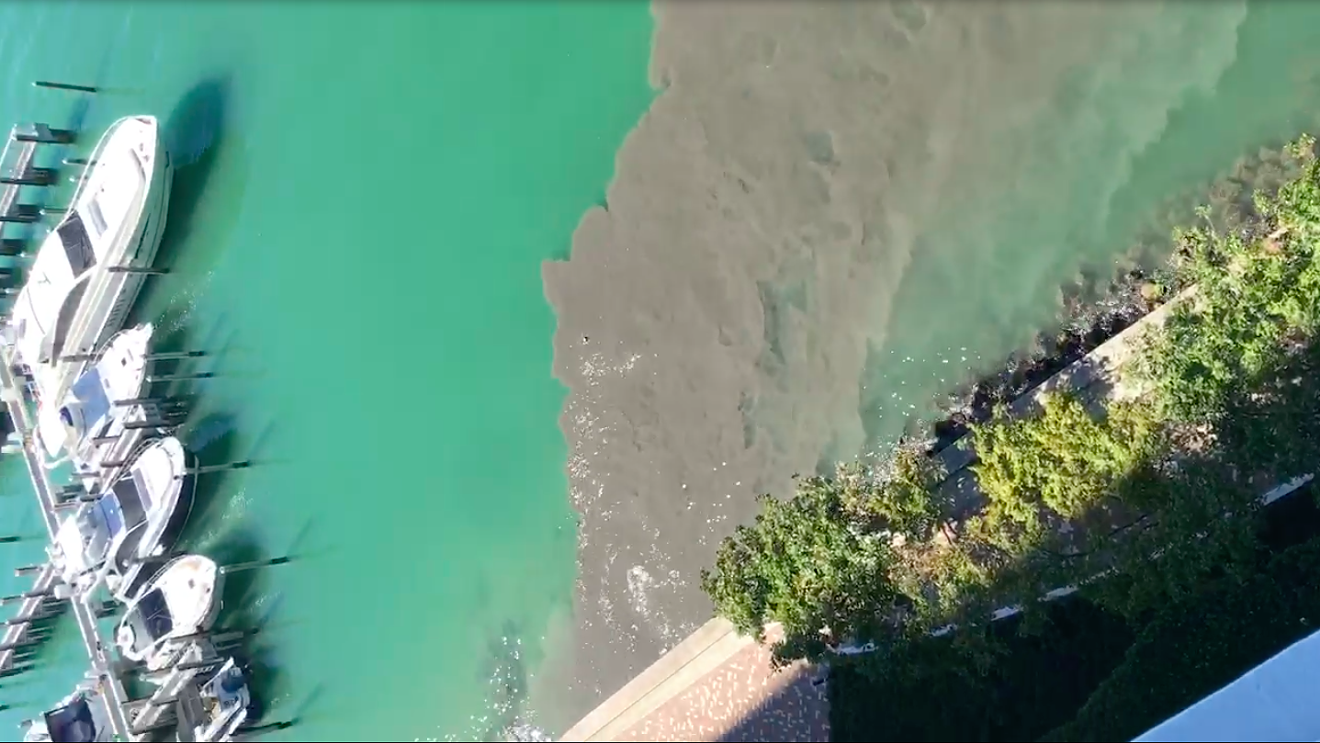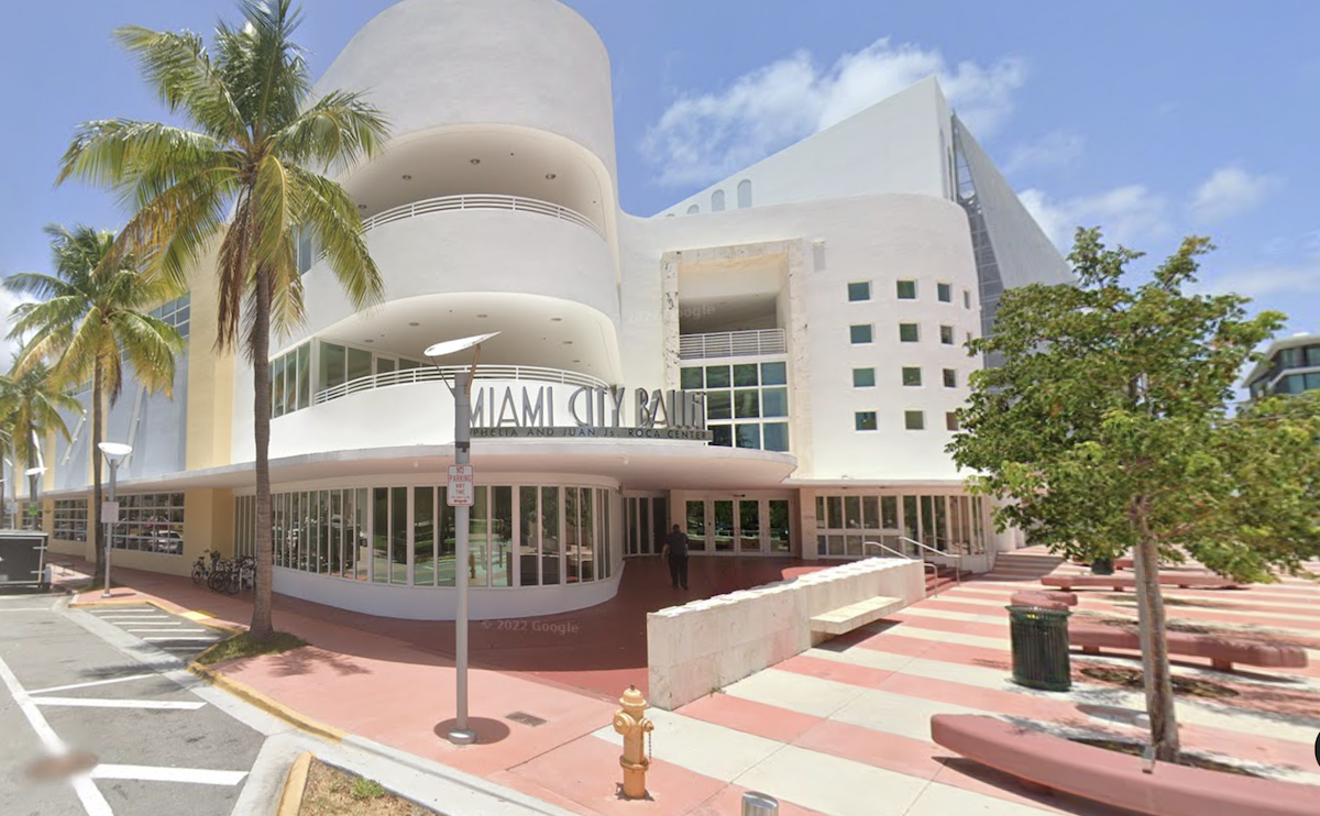On a cloudy Tuesday morning in South Beach, a man stands on a seawall at the edge of Biscayne Bay.
The scene, filmed by a resident at West Avenue and Sixth Street, shows what environmentalists say is a problem with Miami Beach's strategy for combating sea level rise. During former Mayor Philip Levine's tenure, the city installed stormwater pumps capable of sucking streets dry and preventing flooding. But critics — and scientists — say the pumps also deposit dirt, debris, oil runoff, dog excrement, and pesticides into Biscayne Bay.
After the problem was exposed by New Times and the Miami Herald in 2016, Levine — who received wide-ranging national attention for the effort — attacked the stories as "sloppy science combined with sloppy journalism." The pumps continued to operate. Three years later, residents are still seeing murky, polluted water discharged from the pump outfalls.
"This is not OK," says Dave Doebler, a South Beach resident
A citizen complaint about the stormwater dumping at West and Sixth prompted the county's Department of Environmental Resources Management to investigate the site last Tuesday. Spokeswoman Tere Florin says inspectors did not find anything illicit about the dumping but did collect samples that will be tested for bacteria.
In an email to New Times, Miami Beach spokeswoman Melissa Berthier said the city proactively participates in regular street sweeping, litter collection, and environmental inspections to keep trash and debris out of the stormwater system. She said the city has been "diligently investigating" the dirty plume at West and Sixth.
"Despite our multitude of efforts, we occasionally see a cloud of suspended soils coming out at our outfalls, each caused by a different source and situation," Berthier wrote. "When we see a cloud like the one we saw on Monday, we immediately respond to the site to turn off the pump station, if there is one connected to the outfall, and conduct a thorough investigation." (See the city's full statement below.)
Doebler, who founded the Volunteer Cleanup organization, says he became interested in stopping the pollution when he saw trash being dumped into the bay through the stormwater system years before the pumps were installed. While the pumps now catch bulky trash before it can enter the water, Doebler says they do little to keep smaller trash out of the bay.
He also worries that large deposits of dirt from the pumps disrupt ecosystems in the bay, which has shown a massive loss of seagrass; a recent county report found stormwater discharges have played a role in the die-off.
"Let's just say — best-case scenario — it's just dirt (coming from the pumps)," Doebler says. "That actually destroys the bay by basically blocking light from the seagrass on the floor of Biscayne Bay. It allows algae to then grow, further blocking
Miami Waterkeeper executive director Rachel Silverstein, whose organization advocates for clean water, shares Doebler's concerns.
"Stormwater runoff from around the county is one of the major sources of pollution in Biscayne Bay and was implicated in the recent county report released about the seagrass die-off," she tells New Times.
Mike Alvarez, Miami Beach's former infrastructure director and assistant public works director of 22 years, is another outspoken critic of the current stormwater setup. In recent years, the city has installed more than 20 pump stations without injection wells, something Alvarez believes would help clean up the stormwater before it is pumped into the bay.
"Every day, we’re pressure-washing sidewalks — that’s all dirty water. All the alleyways have a lot of grease from washing the containers, kitchen mats from the restaurants. Everything goes into the alleys, and everything goes into the stormwater system," he said at a November meeting of the city's sustainability committee.
At the same meeting, Commissioners John Aleman and Mark Samuelian pushed back on the criticism, saying the city is doing the best it can. "We are constantly challenging what we’re doing," Samuelian said.
"We collectively have to keep pushing the envelope, but we also have to acknowledge that the technology is not perfect," Aleman added. "There’s no technology for that that can operate on an industrial scale. If there was, we’d be implementing it."
Although Miami Beach has contributed to the problem, Doebler says the city alone is not to blame since other municipalities also pump stormwater into the bay. But because of Miami Beach's reputation for tackling sea level rise, other cities are looking to it as a model for best practices.
"Miami Beach is kind of writing the playbook for how coastal communities will adapt to sea level rise, so other cities are starting to put in these pump stations," Doebler says.
Alvarez, the former assistant public works director, says Miami Beach should work to find a solution to flooding that doesn't also pollute the bay.
"The City of Miami Beach wants to be the leader in sea level rise. Why don't you also be the leader in protecting the environment with Biscayne Bay?" Alvarez says.
Silverstein encourages residents to report water pollution through the 1,000 Eyes on the Water program.
"Community reports on pollution are critical to ensuring clean water," she says.
Miami Beach spokeswoman Melissa Berthier provided the following statement to New Times:
"We have a number of best management practices to stop potential sources of pollution before they enter our stormwater system, such as a proactive environmental inspection program, regular street sweeping and litter collection, and fines for littering, among others. We also conduct regular cleaning of our stormwater system, cleaning our pump stations and their treatment structures weekly to monthly and the whole system once a year.
"Despite our multitude of efforts, we occasionally see a cloud of suspended soils coming out at our outfalls, each caused by a different source and situation. When we see a cloud like the one we saw on Monday, we immediately respond to the site to turn off the pump station, if there is one connected to the outfall, and conduct a thorough investigation. Sometimes we are able to identify the source quickly and work with the violator to correct and enforce the issue. Sometimes it requires a more lengthy and in-depth investigation like the investigation currently underway at the 6th Street outfall."
6th Street outfall investigation
"A team of Operations, Engineering, and Environmental staff responded to the incident after the reports were received. Based on their investigation, the discharge appears to be fine soil that remains suspended in the water and is coming from upstream.
"We have been diligently investigating the sporadic discharges from this outfall with our interdepartmental team. Our Operations staff has been using cameras to see inside the pipes and check for damage. Our Engineering staff has been reviewing the design to see if perhaps this part of the system has pockets where organic material sits and deteriorates, creating brown water. Our Environmental staff has been investigating potential illicit discharges and connections, such as dewatering from upstream construction sites, that could be contributing to sediment in the system. We also retained a lab to test for approximately 120 different parameters, including hydrocarbons, bacteria and other indicators of pollution that were not elevated.
"We have not yet found the source of this cloud of suspended soil at this location so we are ramping up our investigations. This week Operations plugged the system, cleaned it, ran it dry, and is videoing it again. If there are any breaks in the aging pipes within the drainage basin connected to this outfall, the video will reveal the issue and their location so we can fix them.
"Also, on Friday, Environmental staff is planning to spend multiple hours to do a very thorough inspection of the neighborhood that drains to this outfall to see if there are any construction activities or other sources of soil that could be draining muddy water into the pipes.
"In the interim, we are continuing to monitor this outfall so we can modify our operations accordingly.
"Let me also add that the manatee at the stormwater outfall does not indicate anything unusual. Manatees often seek the fresh water that comes from stormwater outfalls, and that’s what looks like is happening here."












